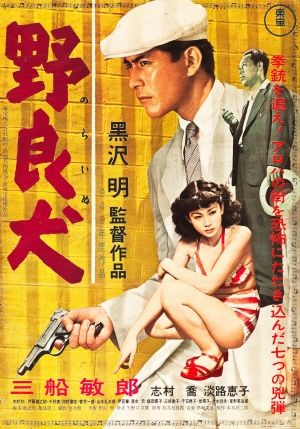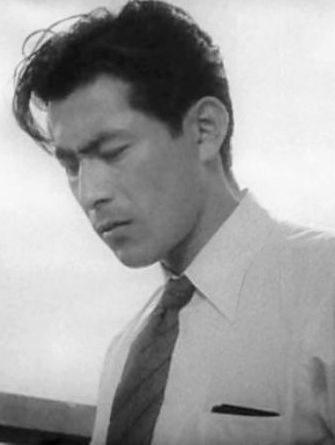Toshiro Mifune @ 100: Stray Dog
 Saturday, March 28, 2020 at 8:00PM
Saturday, March 28, 2020 at 8:00PM Team Experience will be celebrating the Centennial of Japan's great movie star Toshiro Mifune for the next five nights. Here's Lynn Lee...


It’s impossible to think of Toshiro Mifune without thinking of Akira Kurosawa—and vice versa. Their partnership was unparalleled in its cinematic impact, spanning 16 films between 1948 and 1965 that included stone-cold classics like Rashomon, Seven Samurai, Throne of Blood, The Hidden Fortress, and Yojimbo. While Mifune and Kurosawa did significant work independent of each other, it’s not exaggerating to say they made each other; both men would acknowledge as much even after their falling out. In Mifune, Kurosawa found the perfect player to convey the outsize emotions and imposing physical presence of his most memorable protagonists—typically men of strong passions and even stronger will, whether turned to honorable or horrible ends...
Stray Dog (1949), Mifune’s third collaboration with Kurosawa, is an early film in both their careers (Mifune’s seventh, Kurosawa’s ninth) and shows both of them still finding their stylistic stride and revealing why they worked so well together.
Influenced by Kurosawa’s admiration for film noir and the detective novels of Georges Simenon, it centers on a young Tokyo homicide cop, Murakami (Mifune), whose gun is pickpocketed and later used in a series of increasingly violent crimes.

After Murakami’s initial efforts to trace and recover the gun are undercut by his own overeagerness, he’s paired with the much more experienced detective Sato (Takashi Shimura, another Kurosawa regular). Sato teaches the rookie a thing or two about good police work before they finally catch up with the man who has the stolen gun.
Stray Dog is thus something of a proto-police procedural, as well as a forerunner of the now-ubiquitous “buddy cop” movie. It’s a solid, well-constructed example of the genre(s), elevated by Kurosawa’s signature stylistic touches (axial cuts and wipes abound, as does his use of weather as narrative omen). It’s far more interesting, however, as a vivid, then-contemporary portrait of post-WWII Japan under Allied occupation. We see a society struggling with rampant poverty, inequality, and crime, as shots of ration cards and an extensive black market are juxtaposed with seedy dance clubs, zoot-suited yakuzas, and glimpses of the uninterrupted luxury of the upper classes—as well as broader cultural attempts to return to something like normalcy, perhaps best captured in a key scene that takes place at a baseball game.

But what clearly fascinated Kurosawa even more than these external markers was the internal impact of the war on the moral psychology of its survivors. Murakami and Sato represent two different types, separated by generation in their views of moral responsibility and the moral politics of crime – Murakami’s more conflicted and ambivalent, shaped by his experience as a soldier in the war, Sato’s more cut-and-dried, driven as much by pragmatism as anything else. Meanwhile, the main perpetrator of the crimes they’re investigating, Yusa (Isao Kimura, largely unseen until the very end), presents a third axis: where Sato acts as Murakami’s mentor and temperamental foil, Yusa—about Murakami’s own age, a war veteran like himself—is his dark doppelganger, the “stray dog” he could have become had he chosen a different path. If that construction sounds a bit schematic, that’s because it is; Kurosawa’s script doesn’t shy away from spelling out the moral debate, both in Murakami’s discussions with Sato and his climactic showdown with Yusa. What makes it all work is the way it’s filmed and, of course, acted.
 Perhaps the most striking feature of Mifune’s performance here is how comparatively restrained it is. Striking because while there are many qualities one can attribute to Mifune in other Kurosawa films, “restrained” is generally not one of them, or at least not the first that comes to mind. Kurosawa famously first glimpsed the actor at a Japanese studio talent search and found himself immediately “transfixed” by the spectacle of “a young man reeling around the room in a violent frenzy,” whom he likened to a “wounded beast trying to break loose,” and noted that when he had finished, Mifune sat down and gave the judges “an ominous stare.” That raw ferocity is present in Stray Dog, but mainly by suggestion or in flashes. You see it in the glowering intentness of Murakami’s eyes as he’s pounding the pavement of the Tokyo black market or listening to the various witnesses, or the speed with which he leaps to his feet any time he learns of a new clue or lead that he feels compelled to pursue – and, certainly, in his final, intensely physical showdown with Yusa.
Perhaps the most striking feature of Mifune’s performance here is how comparatively restrained it is. Striking because while there are many qualities one can attribute to Mifune in other Kurosawa films, “restrained” is generally not one of them, or at least not the first that comes to mind. Kurosawa famously first glimpsed the actor at a Japanese studio talent search and found himself immediately “transfixed” by the spectacle of “a young man reeling around the room in a violent frenzy,” whom he likened to a “wounded beast trying to break loose,” and noted that when he had finished, Mifune sat down and gave the judges “an ominous stare.” That raw ferocity is present in Stray Dog, but mainly by suggestion or in flashes. You see it in the glowering intentness of Murakami’s eyes as he’s pounding the pavement of the Tokyo black market or listening to the various witnesses, or the speed with which he leaps to his feet any time he learns of a new clue or lead that he feels compelled to pursue – and, certainly, in his final, intensely physical showdown with Yusa.
But for the most part, Mifune’s Murakami is quiet, disciplined, and deferential to his superiors, even as he’s visibly racked with guilt and anxiety over the evils committed with his stolen gun. In his light-colored suit and cap, with his deep-set eyes, clean-shaven features, and expressive but controlled countenance, he looks – and acts – like a young Gregory Peck rather than the fearsome, hard-bitten warrior he would so often play in the future. (Shallow side note: this movie also reminds you that young Mifune was hawt, something harder to see in later Kurosawa roles where he would scowl and contort his expression so fiercely you could easily forget what it looked like in repose.)

Moreover, despite its ostensible focus on Murakami, Stray Dog is in large part a two-hander between Mifune and Shimura, who had previously offset each other effectively in Kurosawa’s Drunken Angel and would do so again in many more films. Here, Murakami is frequently positioned as a silent observer as Sato takes the investigative lead. To his credit, Mifune never tries to crowd Shimura out of the picture, showing commitment to a character who doesn’t really seek to challenge the existing order, even if he does question it at times. But with that piercing gaze, and that perpetual look of tightly coiled energy just waiting to explode into action, he never fully recedes into the background, either.
One senses “the real Mifune” was just biding his time, waiting for a chance to come out and swallow the screen. He would get it, a couple of years later, in a little film called Rashomon.



Reader Comments (9)
What an incredible film. I love Toshiro Mifune as I think his best work is in High and Low as a man who is faced with a decision that is uneasy where he knows he has to do the right thing but at what cost.
An FYI TCM will also be celebrating the anniversary of his birth on April 1st with a slate of his films beginning at 6AM and running all day until 6 the next morning providing a great chance to become more familiar with his work. My DVR will be working overtime all day! This film is included in the tribute.
I have seen some of his work, though not Stray Dog, and so far my favorite is High and Low. The film is very involving and Mifune is great in it.
I really really really hope we get a post on High And Low, a flawless masterpiece. My favorite Kurosawa has always been Throne of Blood, but lately I think it's High and Low. Stray Dog's contemporary setting and its approach to the crime drama genre feels like research to High and Low, but the 60's movies is infinitely more complicated.
This is super random but young Toshiro Mifune looks SO MUCH like Dan Levy (Schitt's Creek). Seriously. Anyone else?
Of course The Seven Samurai is hors concours, but High and Low is in the same class. As are Rashomon and Yojimbo. For a completely different take on Mifune try The Bad Sleep Well. I also have a special place in my affections for Red Beard, a long sentimental medical soap opera that's gripping from beginning to end.
I'm excited for this series. Even though I feel I'm fairly well-versed in Asian film, I've only seen four or five Kurosawa films, and I thought I'd use the Mifune centennial (and my shut-in status, courtesy of the pandemic) to catch up on some I've missed. Stray Dog sounds like something I'd enjoy (as do High and Low and The Bad Sleep Well - thanks, ken s!), so I will add it to my watchlist and look forward to more recommendations.
I hope this doesn't seem disrespectful given this is a centennial for Mifune and he had certianly done some great work with Kurosawa especially in Yojimbo/Sanjuro and Tengoku to Jigoku (High and Low) but I think Shimura is Kurosawa's best collaborator. Not only has he been in more of Kurosawa's films than anyone else, but he provides a steady presence with his everyman quality. Or perhaps I'm just biased because Ikiru is my favorite Kurosawa film.
That said, I hadn't seen Stray Dog before. I never realized baseball was featured so prominently to provide a sense of drama.
One of my Mifune favourites is Kurosawa's Red Beard.
I don’t want to be so superficial but Toshiro Mifune was so effing hot.